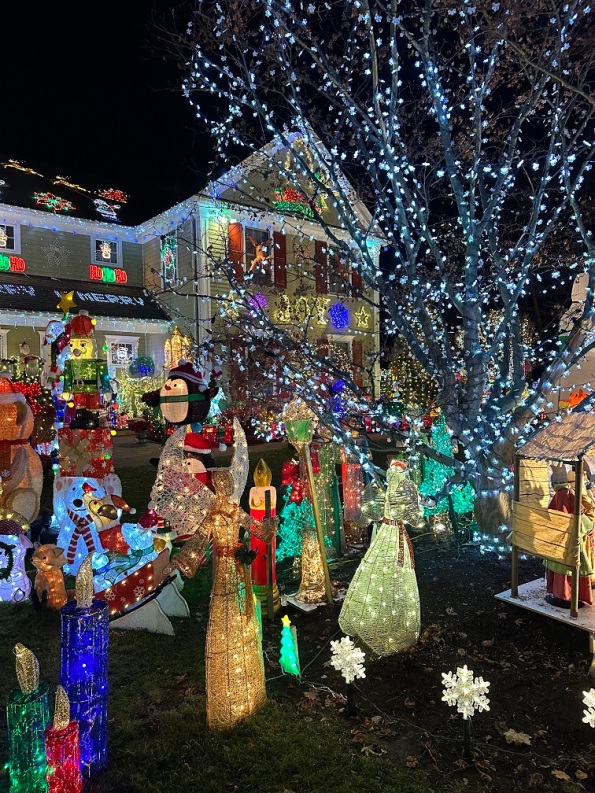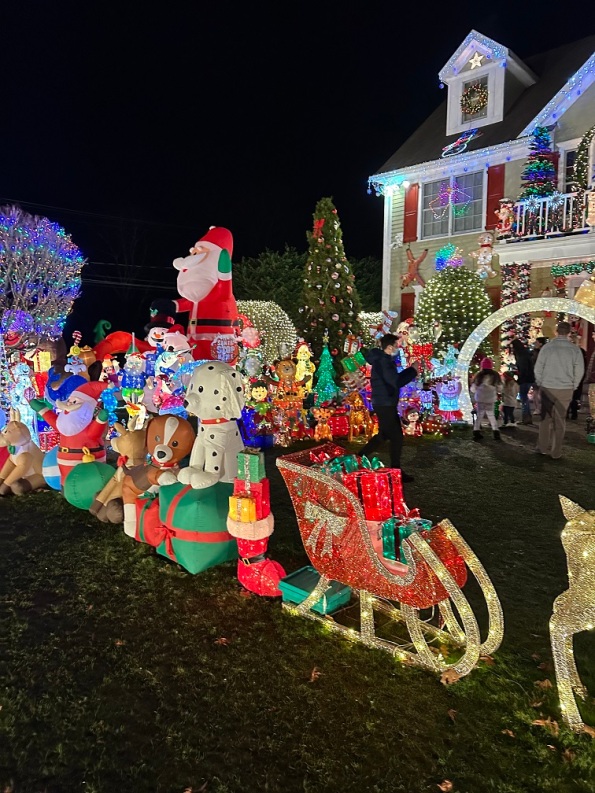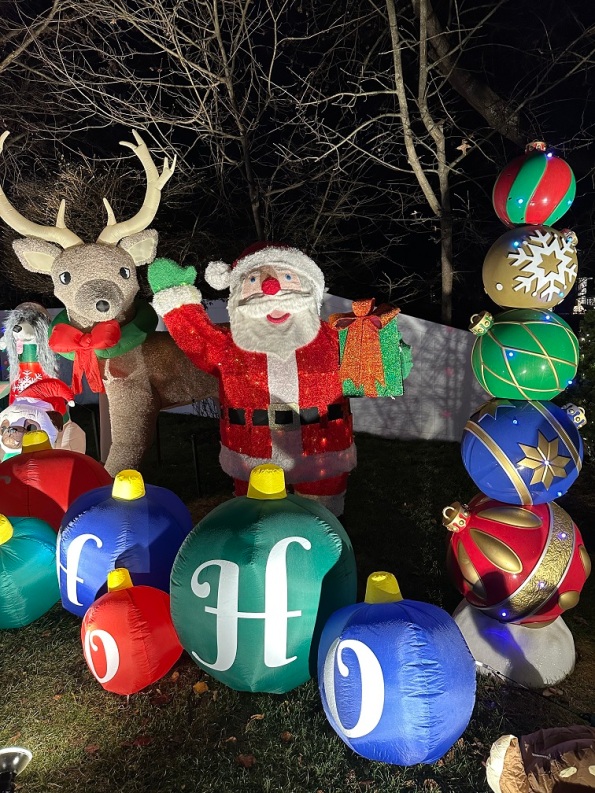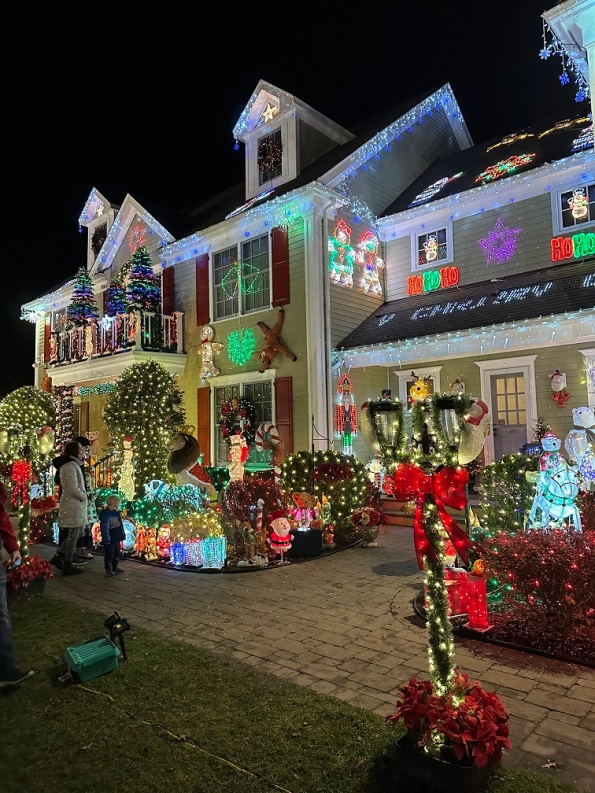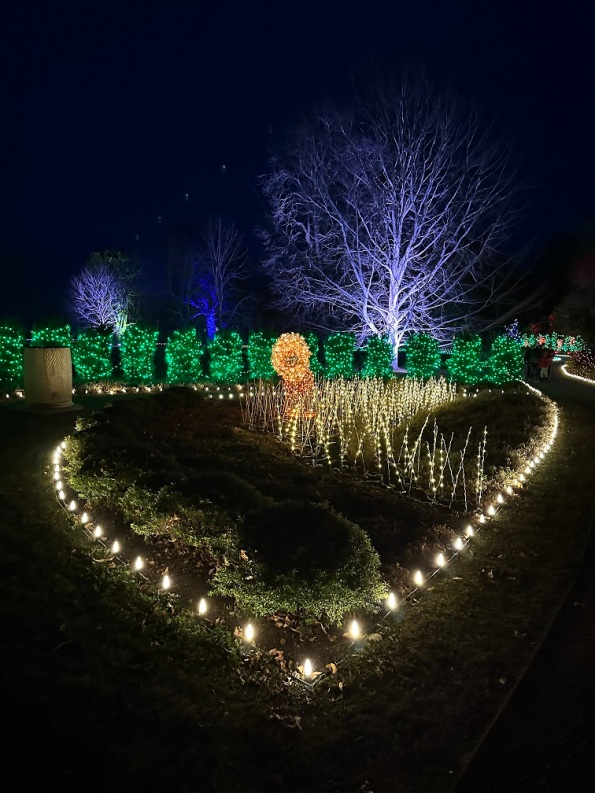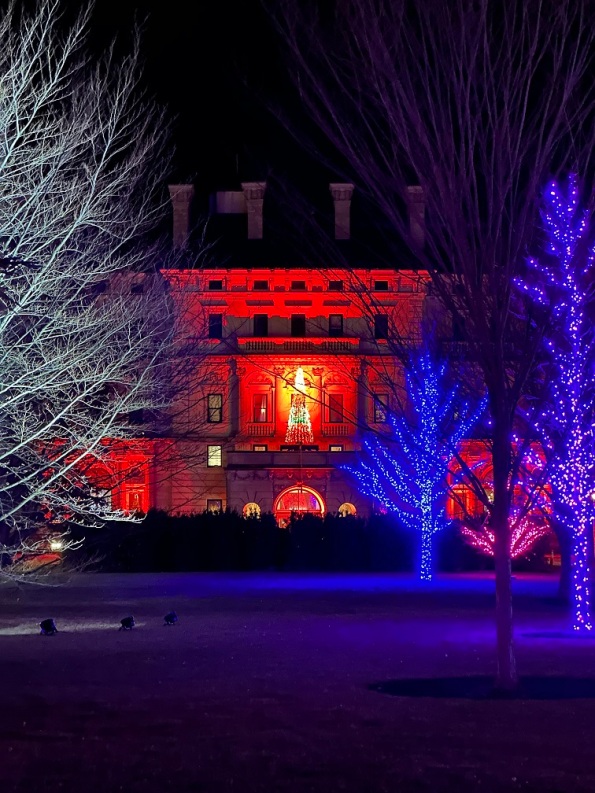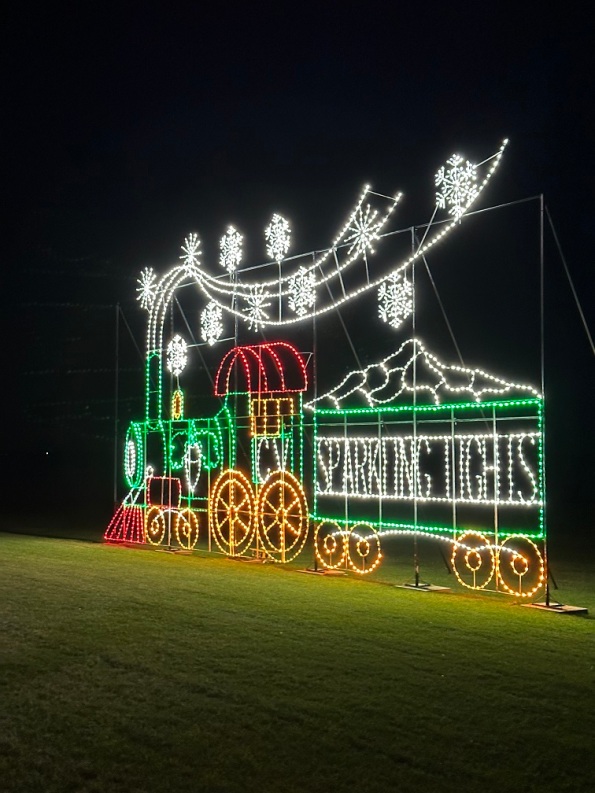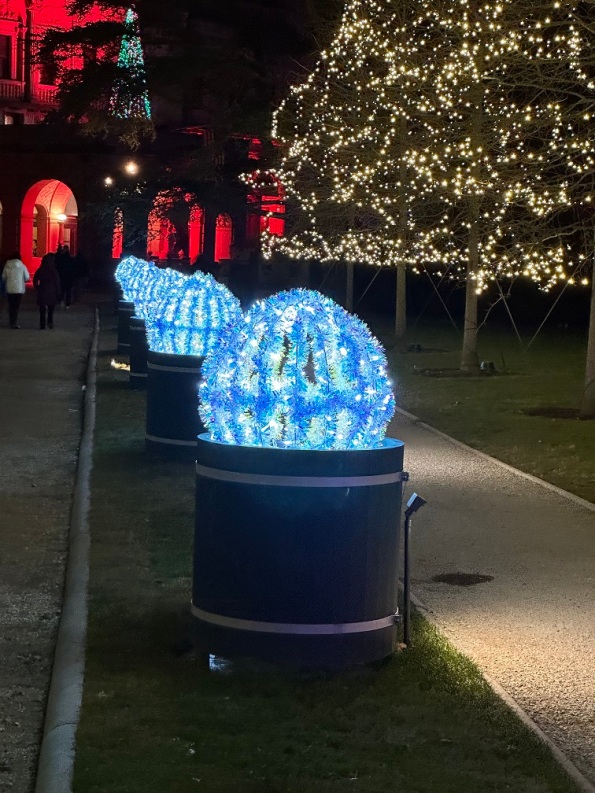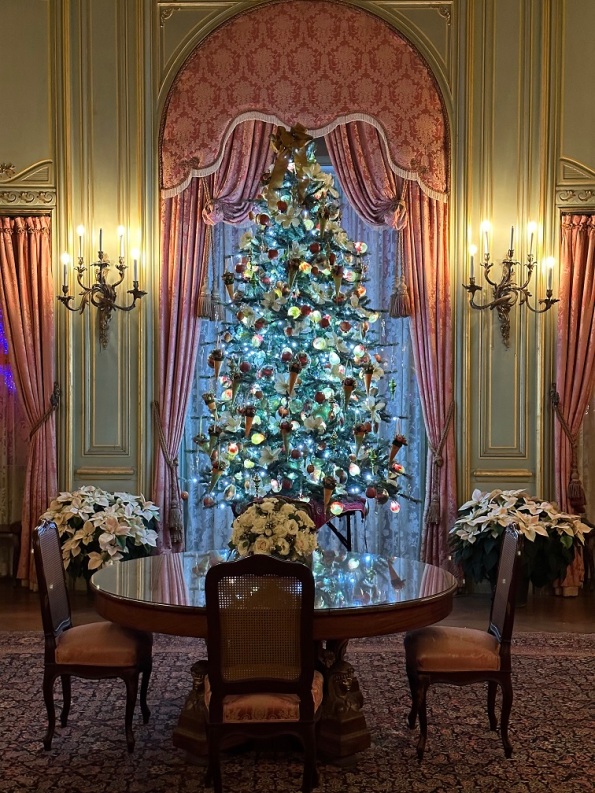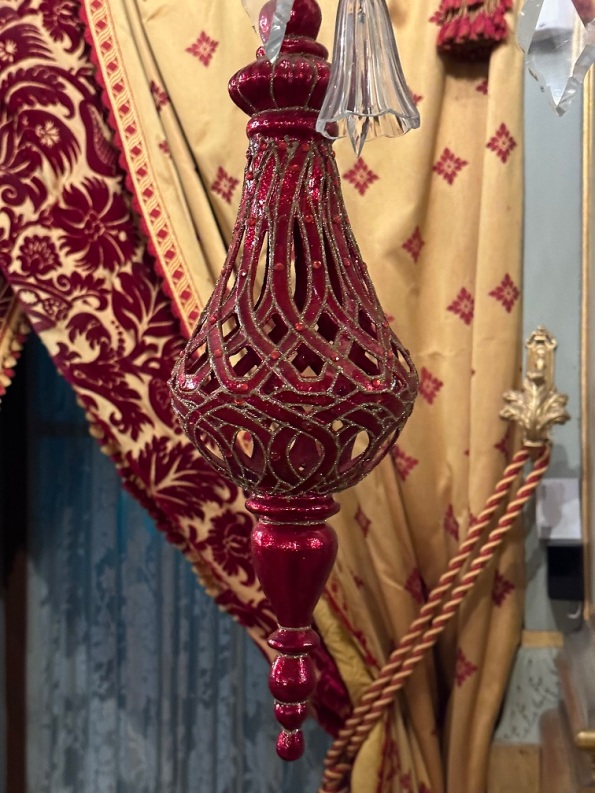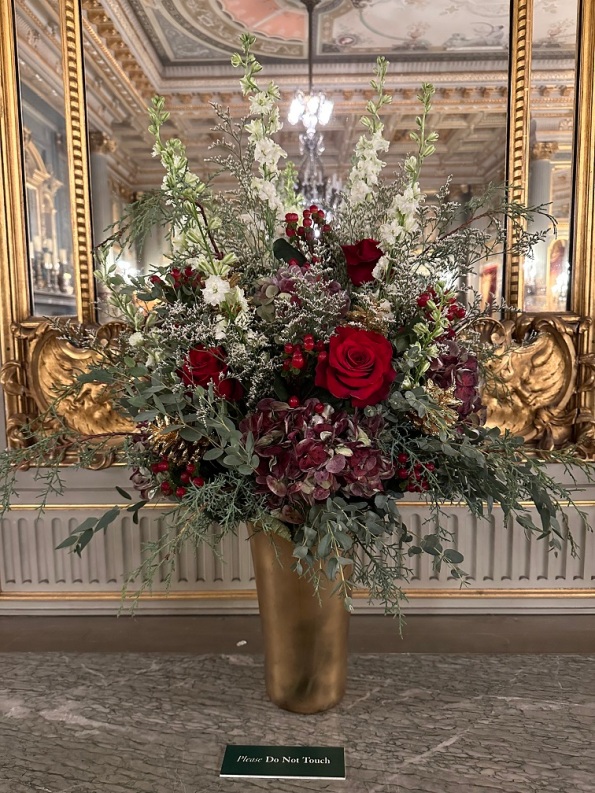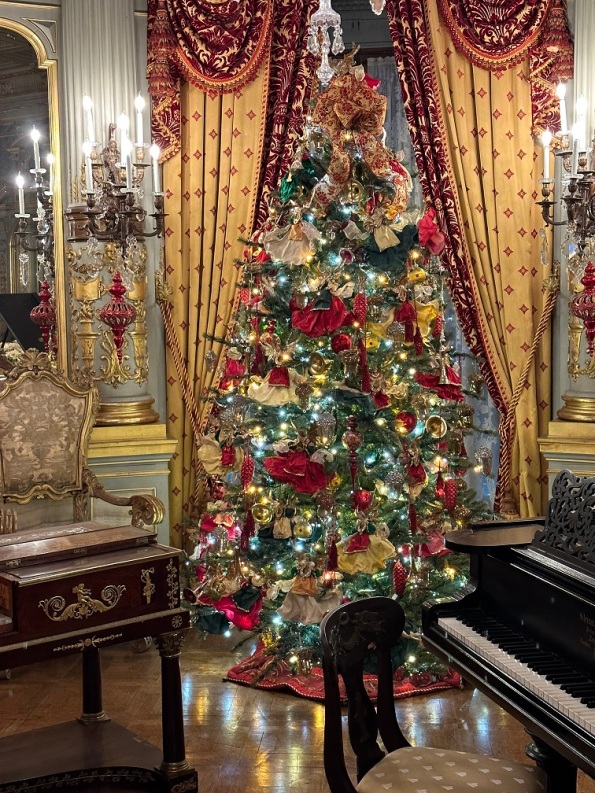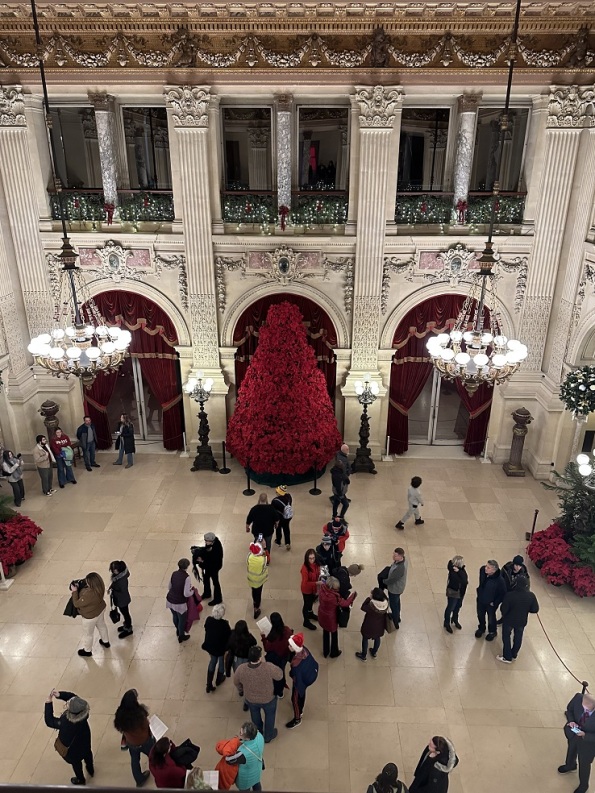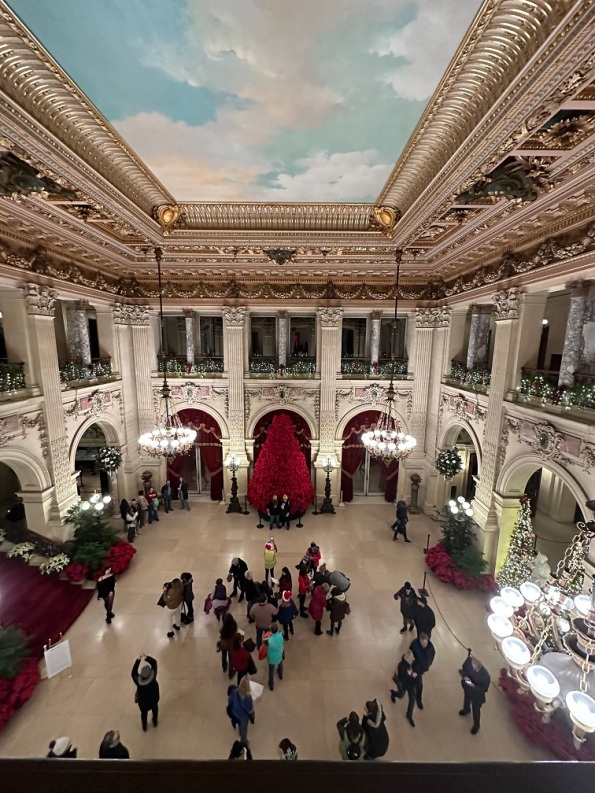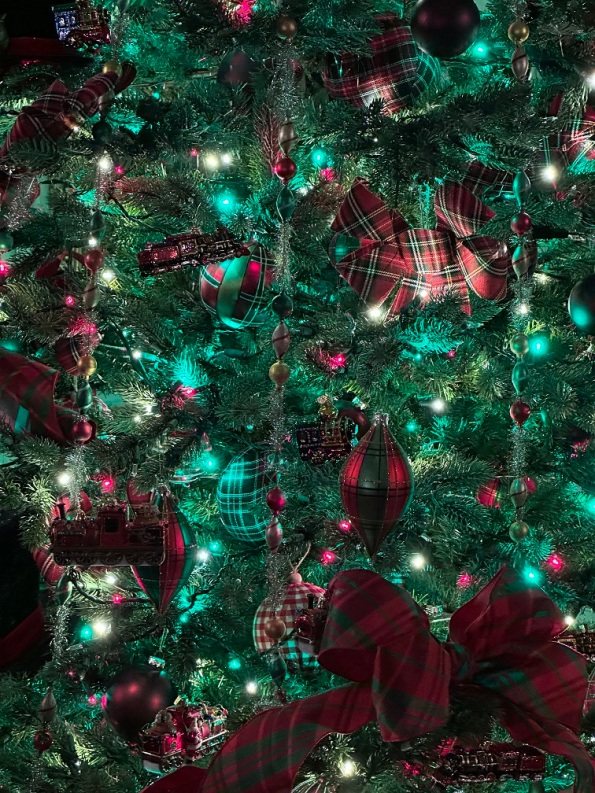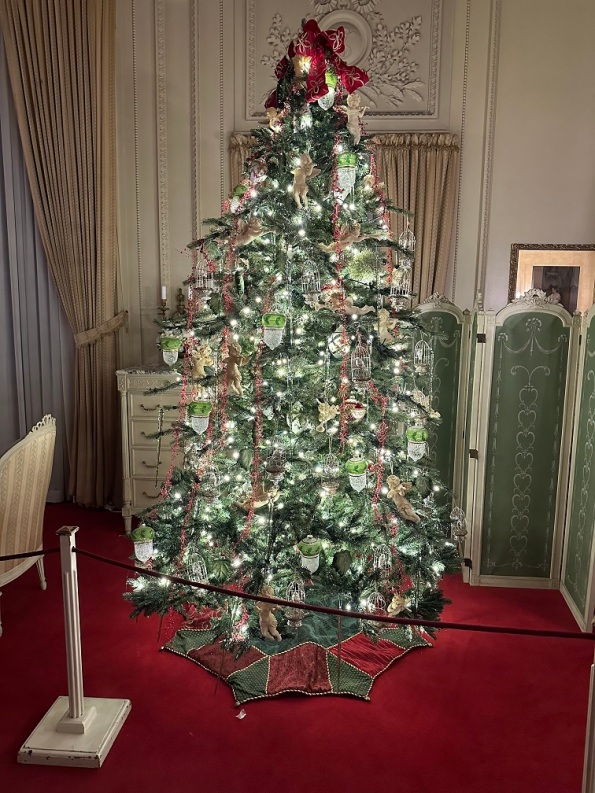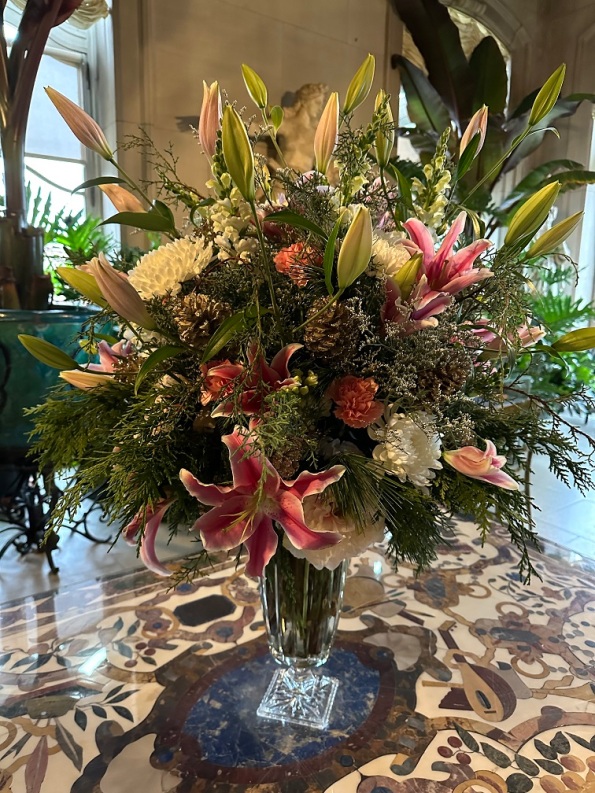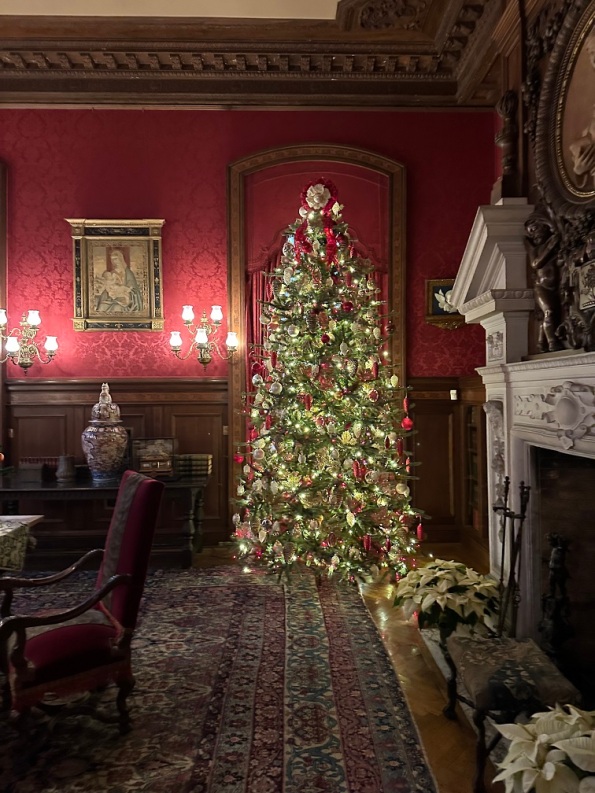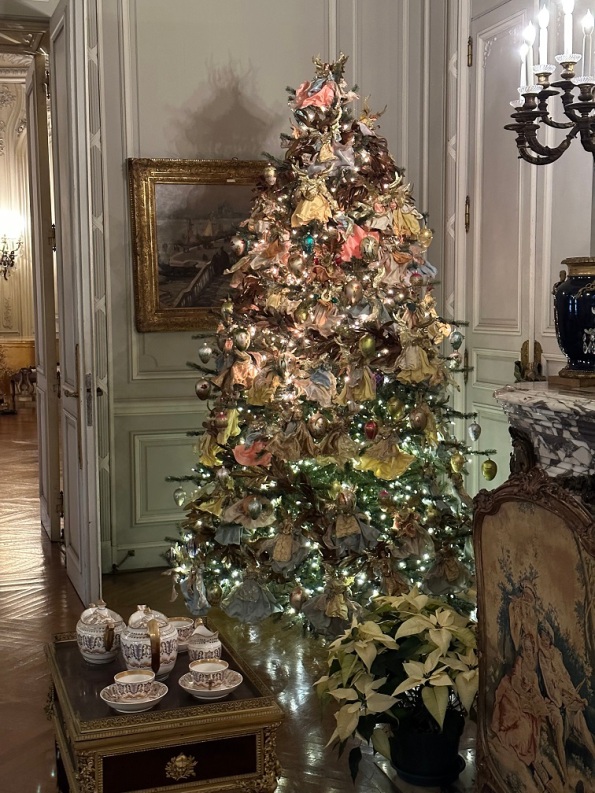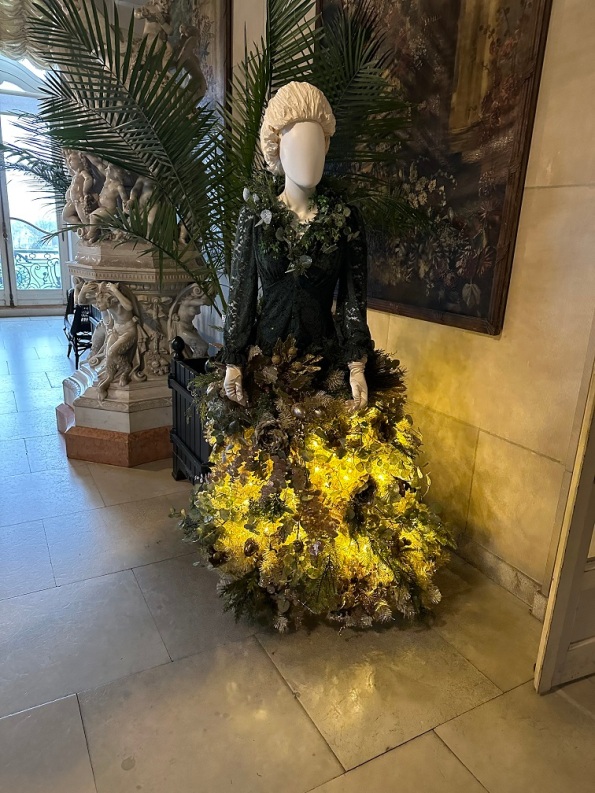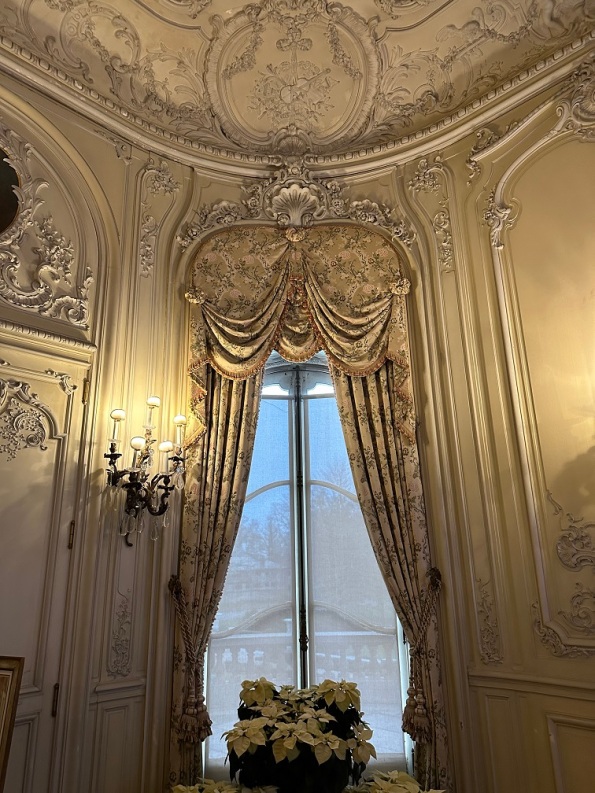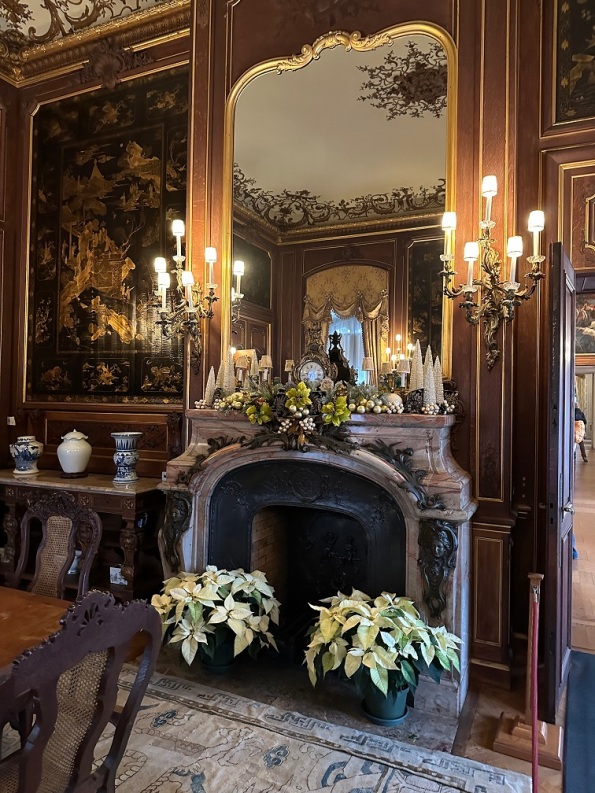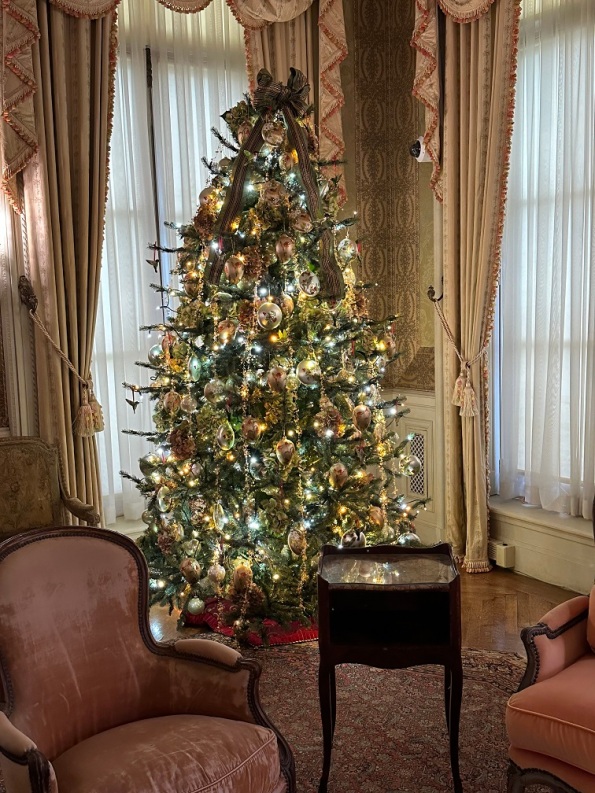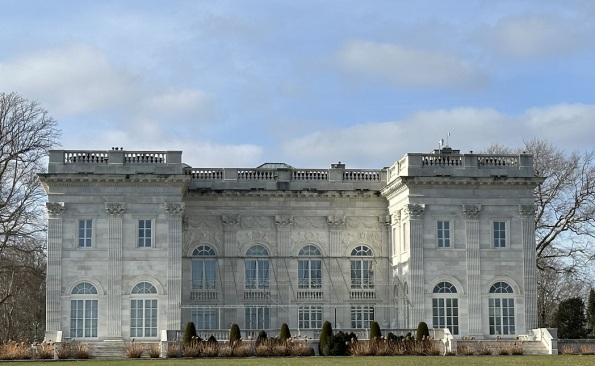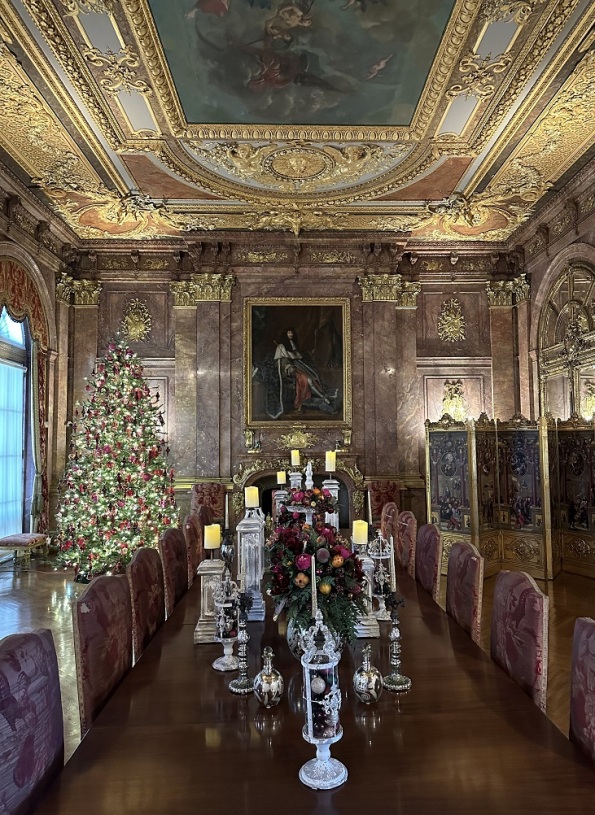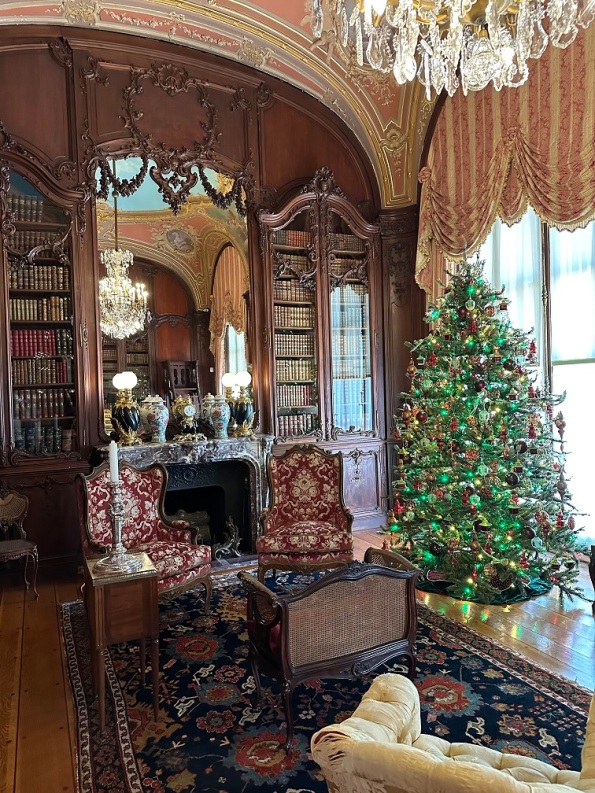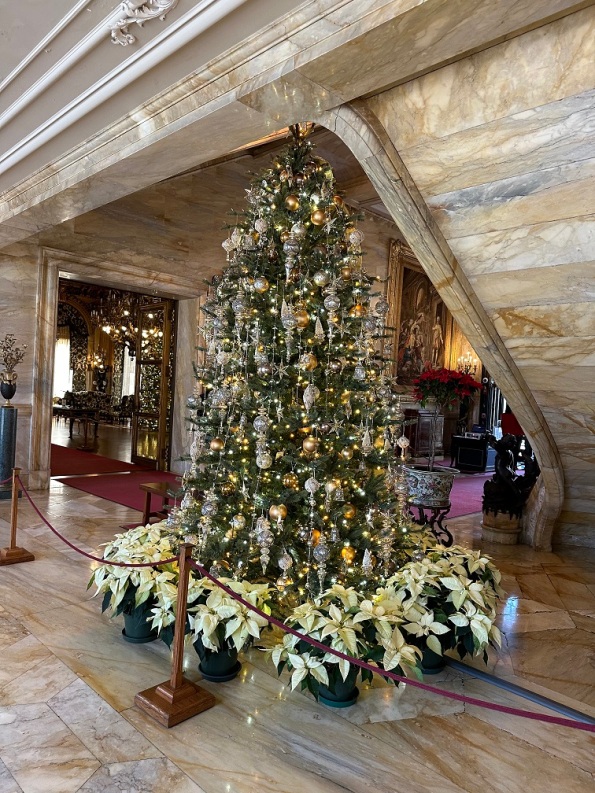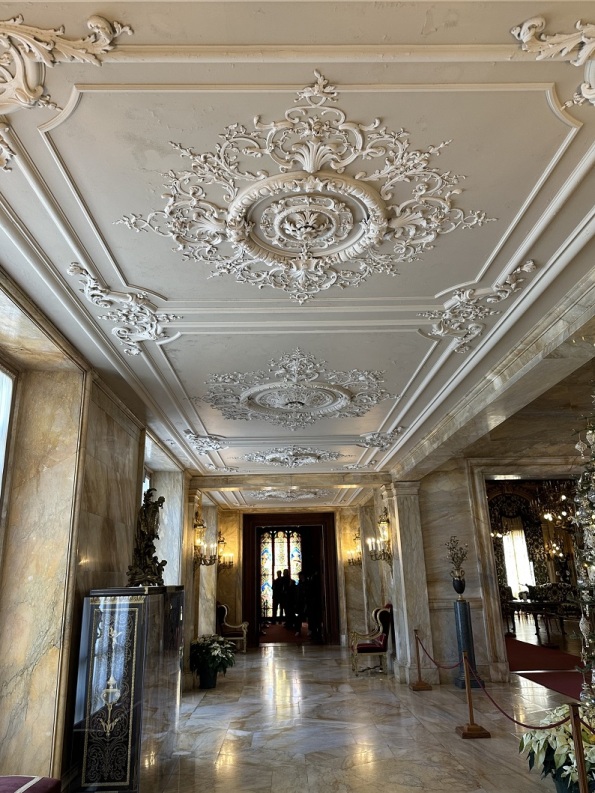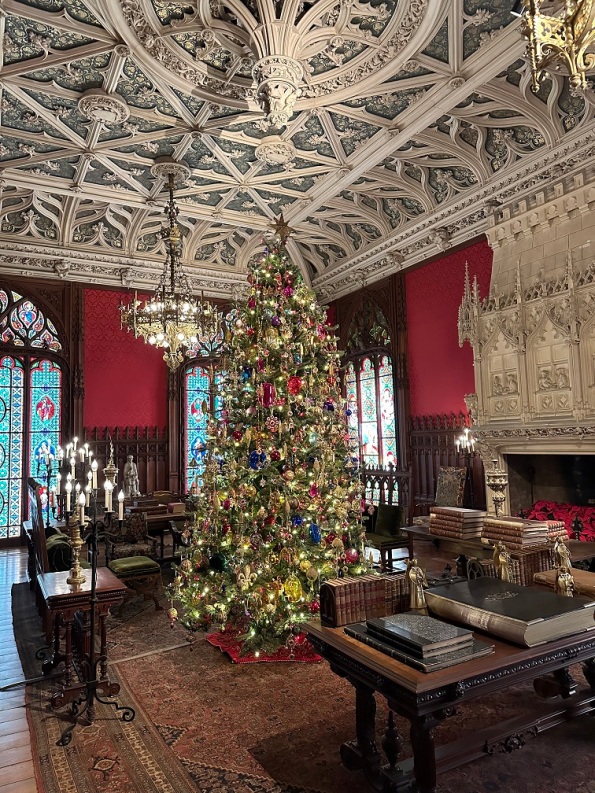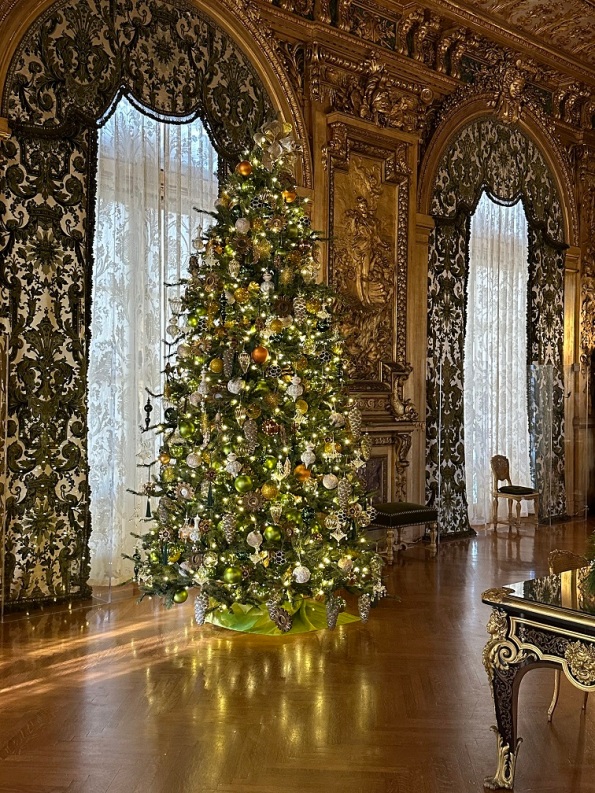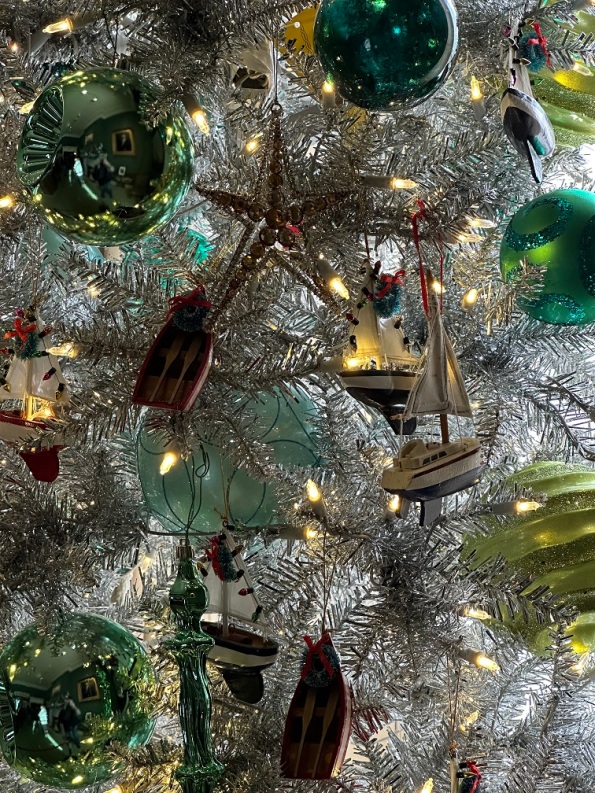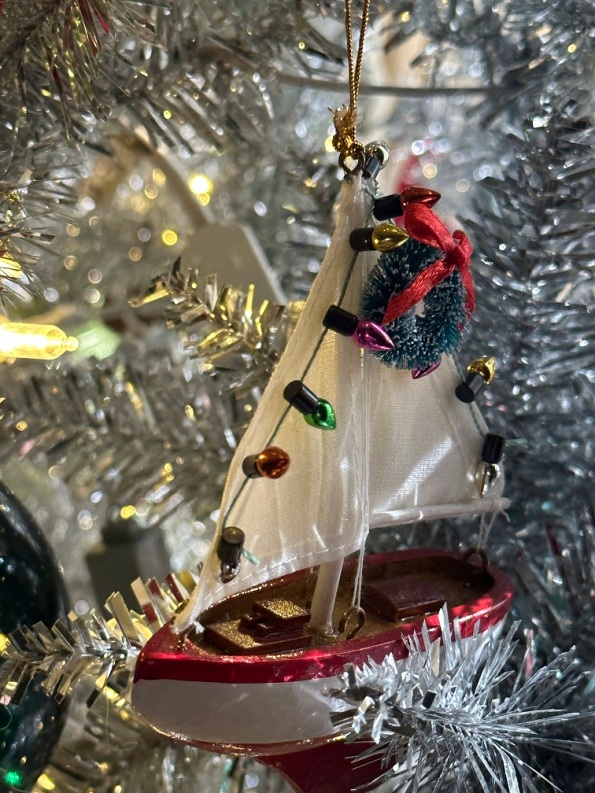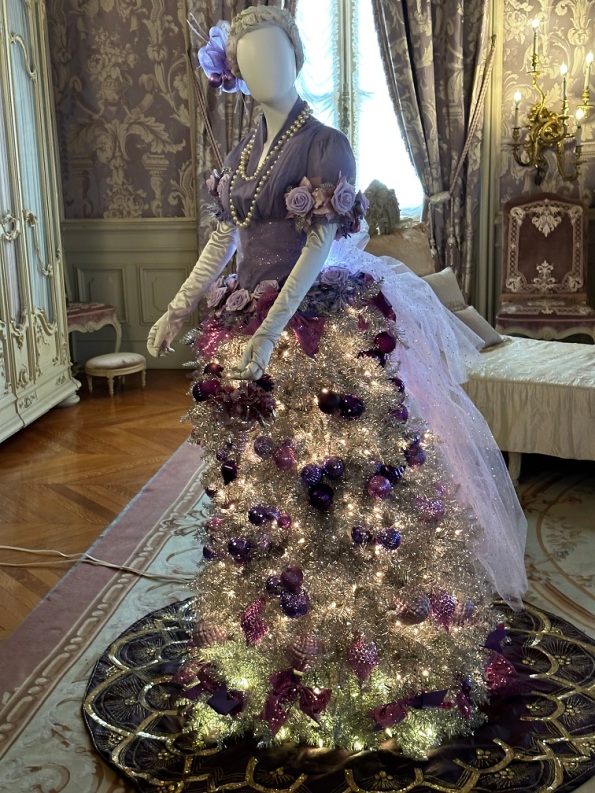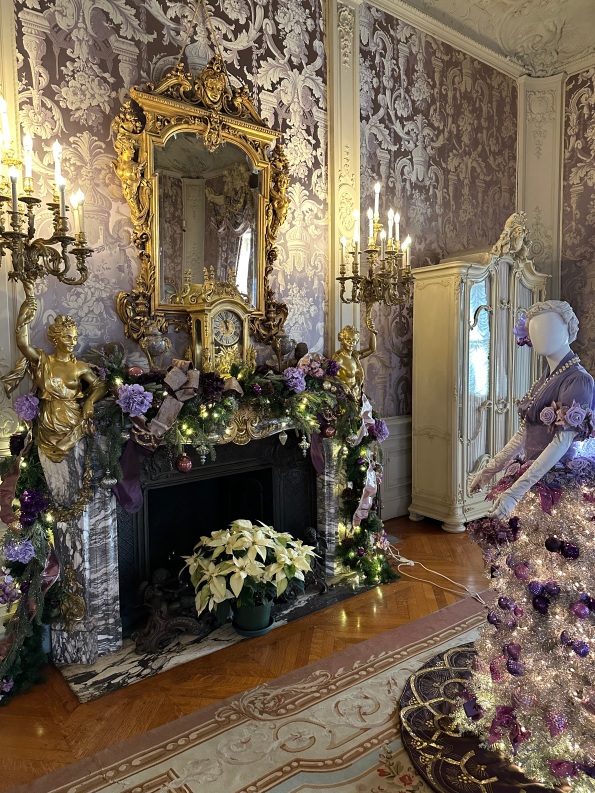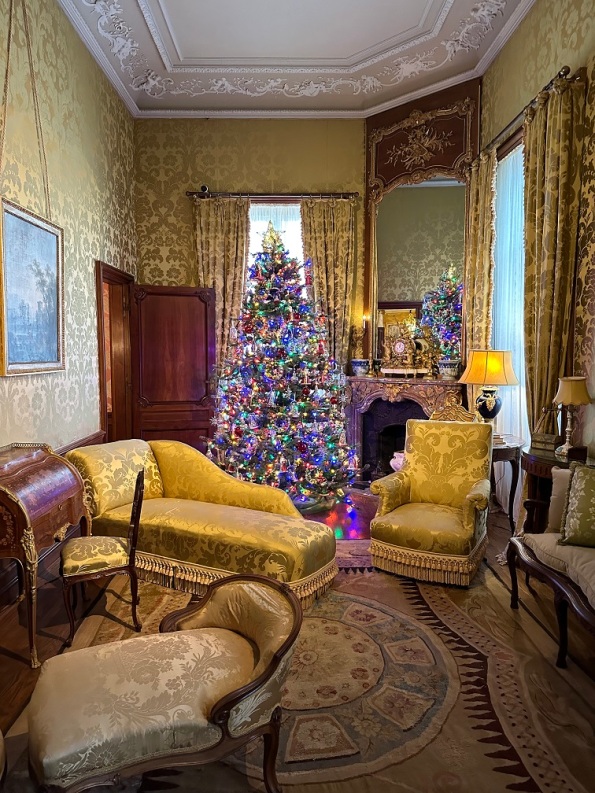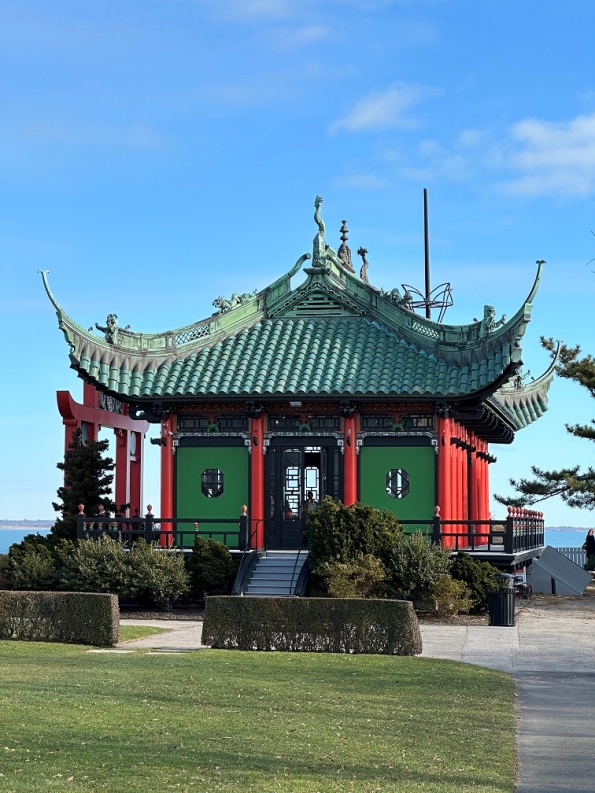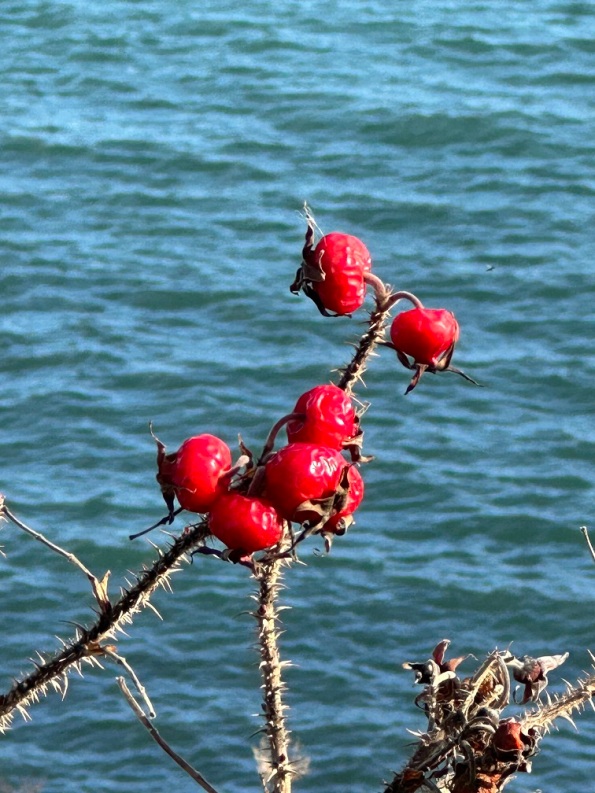Archive
Beautiful Lights, 2023 Edition
While I don’t celebrate Christmas, I still love the lights. I grew up celebrating the arrival of the New Year, and while this was borrowed from the Christmas traditions, there was always a tree for the New Year, ornaments, and lights.
It might be just me, but it seems that the holiday light displays are becoming more widespread, for sure when made as attractions. Or maybe it was always around and I just never took my time to notice them – but I definitely do now.
Newport Rhode Island is one of our favorite travel destinations in general, and particularly during Christmas. We visited Newport back in 2017 to see Christmas decorations, and thinking about that visit, I couldn’t believe that that visit took place 6 years ago. This year, we also decided to visit the Sparkling Lights display which was shown in the evening at the Breakers. As you can imagine, I have a bunch of pictures to share with you. But before we visit Newport, I would like to mention my hometown – Stamford, Connecticut.
Stamford always has some beautifully decorated houses we loved to visit over the years. But this year, we had a “notch up” experience. Driving back from our local supermarket, my wife said “hey, wait, I want you to turn around”. When I asked why, she said that she saw a glimpse of a nicely decorated house on a parallel street, and we should go see it. When we got there 2 minutes later, the view greatly exceeded my expectations – might be the best Christmas lights display I ever saw at a private house – and the best part was that we could park the car and just walk around the decorations. So let me start my inundating display with these pictures:
And now, here are the pictures from the Breakers, the Sparkling Lights display:
Here are a few pictures from the Elms:
And probably my favorite of the whole Newport trip – the Marble House:
Hope you enjoyed!
Frustration of the Oenophile
We have enough sources of frustration in our lives, so wine shouldn’t be one of them. This statement works fine until you become obsessed with wine. Then it becomes a source of joy, happiness, fun, and, of course, frustration.
The concept of frustration is very personable, there is really nothing objective about it. It is generally a choice – you can decide to get frustrated, or you can choose to ignore whatever bothers you. It is not always that simple, of course.
For example, corked wines are a great source of frustration for oenophiles. A corked bottle bothers me very much, but considering my experience with corked wines is not anywhere near the proverbial 8% (knock on wood), I just accept it as an unfortunate part of the wine world. Plastic corks can be a great source of frustration, and so are the bottles with wax tops when the wax is not done right. We can go on with this list and I’m sure every oenophile can choose what frustrates them the most. Most importantly, we feel frustrated with different things on different days.
What prompted this post was frustration with my own choices. And Cayuse wines.
Many years back I was closely following wine writer W. Blake Gray, who was writing a wine column at that time, I believe, for the San Fransico Chronicle. In one of the articles, he mentioned Cayuse Vineyards wines as possibly the best wines produced in the United States. Talk about influences… These got stuck in my head, and getting my hands on the wines of Cayuse became one of my obsessions. I signed up for the mailing list and stayed on the waiting list for close to 10 years until I finally got on.
Cayuse wines are produced by Christophe Baron, a French-born winemaker who fell in love with the rocky soils of Walla Walla Valley. While Cayuse was his original project which brought fame and recognition, Christophe Baron also started a number of other successful projects – No Girls, Horsepower Vineyards, Hors Catégorie Vineyard, and Champagne Christophe Baron (with this he really went back to his roots as he was born in Champagne). While waiting for Cayuse, I actually managed to get on all other mailing lists – but let’s leave those wines aside for a moment and get back to Cayuse.
I’m sure you are curious to see where the aforementioned frustration is coming from – and let me tell you, it is not related to the long wait. My frustration is tied to the wine itself. How? Easy. I don’t enjoy it.
Here, I said it.
Okay, let’s not generalize. I actually enjoyed very much a 9-year-old wine from Cayuse – 2011 Syrah from En Cerise Vineyard in Walla Walla Valley which I had on Thanksgiving in 2020. I liked the wine so much that it became wine #2 on the Top Wines list of 2020. But this happened once. And a few Cayuse bottles that I opened made me question my choices – and became the source of frustration.
The latest case in point – 2017 Cayuse God Only Knows Armada Vineyard Walla Walla Valley (13.8% ABV). This is 100% Grenache. The wine had somewhat of a muted nose, mostly mineral. At first, the palate had a lot of “liquid rock” power – iodine, pencil shavings, granite, maybe cherry pits. I thought that maybe the wine was too young at 6 years of age, pumped the air out, and let it stand until the next day. The next day didn’t improve the situation much. On the third day, the wine simply became bitter.
When I’m supposedly drinking one of the best wines produced in the US, and I derive no pleasure from it, it becomes concerning. It becomes frustrating. What is wrong with me? How come I can’t appreciate this wine? If I look a the reviews, frustration only deepens. Jeb Dunnuck gave this wine 99 points in 2020, and described it as having a “gorgeous nose of framboise, wild strawberries, sweet mulch, sappy flowers, ground pepper, and liquid violets” – how come I don’t get any of this? Do I have to be a professional wine critic to be able to enjoy the wine? By the way, the continuation of the same review made me say WTF: “This carries to a medium to full-bodied, Burgundian Grenache” – Burgundian Grenache? But Grenache is not produced in Burgundy? Yeah, whatever. The same review also suggests the drinking window between 2021 and 2033, so I’m perfectly in the range. And yet I didn’t enjoy the wine.
I love Grenache wines. Admittedly, many of my great Grenache experiences are connected to Spain, where it is known as Garnacha – how about some Alto Moncayo, for example. I very much enjoy Grenache from France – CdP, Gigondas, other places. Also, California is perfectly capable of producing the most delicious Grenache – we don’t even need to go to the Rhone Rangers – Bokisch and McCay in Lodi do a damn good job representing delicious Grenache. And yet I don’t enjoy what should be one of the best renditions of Grenache in the world. Frustrating.
Cayuse will not be the first “serious” wine I’m unable to enjoy (serious = expensive here, this bottle costs north of $130). Opus One, Joseph Phelps, Corison, Chateau Montelena, many of the Heitz bottlings, Far Niente… There are a number of wines out there I do not seek. But I was really dreaming about getting my hands on Cyuse bottles. This wine was an object of desire and now… this?
I believe Bionic Frog was the wine that made Cayuse famous. Bionic Frog (made from Syrah) is still not a part of my allocation, so I will try to stay the course for now. I will give more chances to Cayuse wines to prove that my latest experience was just a fluke, but I’m afraid I have to leave Cayuse wines aside at the moment and see if time will be able to bring out the pleasure.
Yes, I realize full well that my frustration is the first world problem – and if you have a problem with that, feel free…
For now, I will remain oenophile frustrated.
Alcohol Shenanigans
Yes, I know. The title is not great. Leaves a horrible impression. Sounds like a story about college dorm adventures. And yet this is all I can come up with for this post.
“Next time, we will taste tequila,” said my friend before going home after our cognac tasting. “And I will bring Tequila”, she said.
A few weeks ago, the “next time” arrived – she showed up with about 20 bottles of tequila, mostly anejo with a few interesting oddballs. This is where the shenanigans started.
Mirriam-Webster: Shenanigan Definition: “a: tricky or questionable practices or conduct“
Let’s begin with the fact that we had no idea how you are supposed to taste tequila. Tequila is generally not considered a sipping liquor. Go to the bar, ask for tequila, and it will be served in a shot glass. And here we were not planning on any shots – the plan was to taste tequilas the same way as we do the cognac and scotch. After a short(?) brain freeze, we settled on small glasses – for the people in the US, if you ever bought Tiramisu dessert from Costco – these are the glasses I’m talking about. And off we went.
I think we went through almost a full lineup the first night. I’m sure we made a number of mistakes in the order, as some tequilas tasted sweet and not even reminiscent of a traditional agave – and they tasted very different the next night. And I didn’t mention it before, but we went a bit beyond tequila in the tasting – we also had Mezcal and Sotol. While I’m familiar with Mezcal as a category (side note: Tequila is a subset of Mezcal. Tequila can be made only from blue Agave, but Mezcal can be made from 30 different types of Agave), Sotol was completely new to me.
Sotol is a distilled spirit from Chihuhuan desert in northern Mexico made from the plant called Desert Spoon (there are other scientific names for the plant, but I will leave it for you to research). The plant takes about 15 years to mature, and the yield is about one bottle per plant. Sotol is clearly not widespread at the moment, so I was happy to expand my liquor vocabulary.
This tasting was just for fun, so as you might imagine, I didn’t take any notes. Therefore, the below is just a collection of impressions. We had 3 different types of Don Julio. The Riposado was good, Anejo was very good, and neither one of us cared for Don Julio 1942 Anejo (I call this “overdone”). Chinaco Blanco tequila was very good, restrained and herbal. 1800 Anejo was very good, however, 1800 Anejo Cristalino was even better. I guess when the color was removed to make regular Anejo of the clear color, some of the impurities were filtered out as well, so the resulting tequila was one of the smoothest ever.
Costco’s Kirkland Tequila Anejo was somewhat unimpressive (ok, but too light) – I’m sure it is fine for the money. At some point, we tasted my beloved Tres Generaciones Anejo, which I always compare with the cognac based on its smooth and mellow showing. It had such a pronounced agave taste that I even brought my own bottle thinking that something was wrong with the bottle my friend brought, and my bottle tasted identical. No idea what has happened.
Don Roberto 1924 Anejo was a favorite of my wife and my friend. I liked it too, but it was not my favorite. Casino Azul Anejo, Ocho Single Estate Anejo, Patron Anejo, Centenario Anejo, San Matias Gran Reserva Extra Anejo were all solid, excellent tequilas I would be happy to drink (sip) any day – and yet we had a few more that fared just at an exceptional level.
Wait, before we get to the exceptional ones – the promised oddballs. First, there was not an oddball, but an absolute curveball – 21 Seeds Cucumber Jalapeno Tequila Blanco. It was incredibly spicy to the point of not being able to taste much of anything after a small sip of this fire water. I guess this would be okay as a cocktail mixer, but this is not something I would enjoy by itself.
Los Magos Sotol was very interesting. The herbs were very pronounced on the palate, together with green pepper (not spicy) and cucumber. Truly a unique taste, in a league of its own – of course it makes sense as this was my very first Sotol without any frame of reference.
Next was my personal favorite liquor of the tasting – Mezcal Ilegal Anejo. A typical Mezcal has smoke, both on the nose and on the palate. This Mezcal was truly something else. The only reference I can offer to you is a freshly made log cabin. I don’t know if you ever walked into the log cabin which was recently built – the one that has a smell of freshly cut lumber, this sweet aroma that I can’t really describe. But if you ever experienced that, and if this is something you enjoy, this Mezcal was instantly transporting you to such a cabin – you didn’t even need to close your eyes.
The last Tequila was truly the king of the first night – Gran Centenario Leyenda Extra Anejo. It was round, it was smooth, it was delicious – and it was hiding the agave flavor perfectly well. When I tasted that tequila, I said – tomorrow we are going to compare our “best in show” with cognac. And then we will bring the scotch if we have to.
There is still one more tequila to present – Maestro Dobel Atelier Extra Anejo. A very unique and unusual bottle to begin with. And as far as tequila itself is concerned, it was very round, but somehow was leaving me unmoved, especially in comparison with Gran Centenario. So when we settled for the night’s favorites, Maestro Dobel was not in the picture – but it was a runner-up.
I have to say that I was discouraged by a somewhat puzzling showing of some of the favorite tequilas, so I was convinced that we are not doing the tasting right. The next day, I decided to do a search online to look for recommendations regarding the proper way of tasting the tequila. In one of the first videos, I came across the recommendation to use the Champagne flutes – which made good sense. Our next night’s tasting of Tequila versus Cognac was done using Champagne flutes for Tequila and standard brandy sniffers for the Cognac.
Before we started, I was absolutely sure that cognac, pretty much any decent cognac would have no issues beating tequila in side-by-side tasting. Of course, the only comparison metric we used was a simple “Which liquid do you like more”. And my friend insisted that Dobel Atelier has to be in the tasting – I agreed without much enthusiasm.
As we moved along in the tasting, a simple truth emerged – nothing could beat Dobel Atelier. Granted, I didn’t have the XO-level cognacs to throw into this battle, but we had a few of the excellent cognac specimens – Pierre Ferrand Reserve, Hardy Legend 1863 (spectacular cognac), Park Borderies Mizunara Oak – and Dobel Atelier was still smoother, rounder, and richer than any one of these.
The next night we brought in the Scotch which we both love tremendously. Not only that, but we also decided to switch glasses again and this time we did the tasting using proper, official Glencairn Whisky Tasting glasses. But the story repeated itself. Macallan 15, Macallan 18, Highland Park 16, Lagavulin 16, Glenmorangie 18, Compass Box Affinity – Dobel Atelier was unbeatable…
Truth be told – Dobel Atelier was the most expensive bottle compared with anything else we tasted – if you can find this bottle here in the US (my friend brought it directly from Mexico), it would set you back at least $250. But – I learned about the price of this tequila only after we were done with the tasting, so this was definitely not the factor – and if anything, it would have an opposite effect on me (I’m always a lot more critical of the expensive bottles versus the more reasonably priced ones).
Here you can take another good look at our alcohol shenanigans. Was this tasting a stupid idea? Quite possible. Was it lots of fun? You bet it was. And nobody got hurt 🙂
I’m not trying to be your source of inspiration, but hey, maybe you want to try such a tasting on for size? Cheers!
A Weekend In Unique Wines
A unique wine.
A unique concept.
We can take it to the extreme if we want. Wine in the bottle is a living thing. Wine is changing – for the better or worse, but wine is changing – enzymes are breaking, tannins are fading down. We can claim that every bottle of wine is unique, and similarly to “you can not enter the same river twice”, you can not taste the same wine twice.
Okay, let’s move away from such highly esoteric spaces, and let’s talk about personally unique wine happenings – and I will do my best to explain why I designate each encounter as “unique”.
Unique wine case #1 – “I never had it before”
“light golden color, guava, herbs, med-intensity, inviting; vanilla, apples, lemon, crisp, fresh, round, clean med-long finish” – in all modesty, I’m quoting the description of the wine from my own tweet a few days ago. Looking at this description, what wine do you think was in my glass?
Give it a thought for a few minutes. Meanwhile, I continue.
I will not be playing this #inmyglass game here, of course – especially since I actually borrowed this game from Le Bon Vin #inmyglass. The game was played on Twitter, asking people to identify the place and the grape(s) this wine was made from.
Chardonnay. Chennin Blanc. Sauvignon Blanc. Bordeaux Blend. Garganega from Soave. Lugana. Vermentino. Roero Arneis. These were some of the guesses, I’m sure I’m also missing a whole bunch.
Once we established the place – Italy – and after a few strong hints that the wine is a “curveball” and “thinking out of the box required”, we arrived at the correct answer.
Sangiovese in Bianco. A white wine made from red grapes.
It will not be the first – two out of the 3 main grapes in Champagne are red; Pinot Noir Blanco is quite popular in Oregon; I also had white Merlot and even white Cabernet Franc – and it will not be the last, I’m sure, but this was my personal first experience with white Sangiovese wine.
From the very first whiff 2021 La Loggia Toscaia Sangiovese in Bianco Toscana IGT (12.5% ABV) was special. Beautiful aromatics of guava and herbs, followed by a brilliantly balanced presentation on the palate, with lemon, apple and vanilla, crispy, fresh, delicious. If I would try this wine in the blind tasting, I would confidently make my bet on the old world Chardonnay – and yet this wine was made from Sangiovese.
I got this wine from the Last Bottle wines, which means that I might never see the same one again (I have a few more bottles to see how it will age) – but to my delight, I learned that an increasing number of producers offer Sangiovese in Blanco – I just hope the others will be as good as this one.
Unique wine case #2 – I might (will?) never try this again
Every Champagne lover knows Bollinger. A legendary producer whose Champagne was often 007’s wine of choice (yes, it is James Bond I’m talking about). Bollinger even produces one of the Champagnes under the “007” name. But I’m not talking about Champagne here.
Champagne appellation laws allow production of the still wines. The 2002 Bollinger Ay Rouge La Cote Aux Enfant Coteaux Champenois (12.5% ABV) is red Pinot Noir wine, produced from 2 acres of vineyard called La Cote Aux Enfant located in the heart of Grand Cru Aÿ region and aged in oak casks. This wine is only produced by Bollinger in exceptional years. I had this wine once 9 years ago, and at that time the wine was quite powerful, requiring some time to breathe. This time, the wine was ready to drink from the get-go, offering mostly the tertiary aromas – plums, dried fruit, still having enough acidity and some structure. My daughter offered probably the best descriptor for this wine – she said that the aromatics remind her of an old book – in a good sense. It is the book you lovingly and carefully take into your hands, expecting the magic to happen as you turn the pages. Do I wish I opened this wine 4-5 years ago? You bet. Did I regret my choice of keeping this wine for as long as I did? Not for a split second. A perfect rendition of the mature wine…
Unique wine case #3 – back from the dead and then red with cheese? Surprise!
1998 is one of the special vintages in my book, and I am always on the lookout for 1998 wines for a reasonable price. When I saw 1998 Chateau Saint-Nicolas Fronsac AOC (12.5% ABV) for $19.99 at Wine Exchange, I couldn’t help but grab a few bottles. I opened this bottle right after the 2002 Bollinger. The aromatics were very restrained, and on the palate, the wine just had some glimpses of fruit, but overall the wine gave an impression of the Bordeaux I don’t want to drink. A few hours later, things turned even to the worst – the wine was offering nothing on the nose or on the palate. Of course, it tasted like wine, but it had nothing going I would be able to apply any descriptor to. It was late in the day, so I pumped the air out and decided that I will deal with the wine the next day.
The next day I reopened the wine having literally zero hope for anything even half good happening to this bottle. The smell from the glass offered a glimpse of hope – dark fruit and a hint of eucalyptus showed up. To my delight, the palate completely transformed, offering silky cassis, anis, and lots of herbs. The wine didn’t even give out its age, it was still perfectly fresh with a good amount of acidity.
I had a small cheese board on the table, and without much thought, I took a sip of wine after a cracker with cheese. Combining wine and cheese is a lot more difficult than people like to think, so once again, I didn’t expect much. All of a sudden the taste buds jumped of joy, because the cheese, Bucheron soft-ripened goat cheese from Trader Joe’s, was perfectly complemented by this 21-year-old Bordeaux, creating a new level of hedonistic pleasure. A unique wine transformation and a unique pleasure of elevated food and wine experience – the experience worth remembering.
Here you are – my report on the weekend in unique wines. When was the last time you had a wine which you considered “unique”?
The Land Whispers… You Just Need To Listen
 I love wine dinners. Especially the wine dinners with the winemaker.
I love wine dinners. Especially the wine dinners with the winemaker.
I dread wine dinners. Especially the wine dinners with the winemaker.
I know, I don’t make much sense at the moment. Wine dinners are wonderful, and I really do love them. The dreadful part comes from the experience of not being able to write about those wine dinners in a timely fashion. “Timely fashion”, huh – there are wine dinners I never wrote about in 5 years and such memories can hunt you down – they definitely do for me. I don’t know why this is happening on a regular basis – the elation often experienced during open and engaging conversations about wine becomes an ephemeral spirit, woefully resistful and easily escaping the slightest attempt to capture it in the form of words…
Let’s see if I will be able to break my unsettling tradition.
Last week I had a wonderful time and experience tasting the wines of Viñedos Veramonte and speaking with Gonzalo Bertelsen, General Manager and Head Winemaker in a small group of wine lovers, around the dinner table at the Monterey Brasserie in New York. The conversation topics were ranging from low-alcohol wines (is that really a trend? Are people really asking for it or is that just a gimmick?) to the production of organic and biodynamic wines to “why Germans don’t want to drink organic wines from Chile” (I will not tell you why but you are welcome to guess) and to many other far and between. But most importantly we got to enjoy Viñedos Veramonte wines with and without the food.
Viñedos Veramonte was one of the first wineries in the Casablanca region, founded in 1990 by Agustin Huneeus, a Chilean wine pioneer. From the very beginning, the winery embraced organic viticulture – and more recently, the winery spent more than 6 years making estate vineyards officially organic certified, obtaining ECOCERT® organic certification, one of the most respected in the world. The project involved the conversion of more than 1,200 acres of vineyards in Casablanca and Colchagua valleys to organic and biodynamic farming, with the aim to also become fully Demeter’s biodynamic certified – which requires making changes in the winery, not only in the vineyard – plus importers also have to be biodynamic certified.
Viñedos Veramonte produces 4 distinct lines of wines – Veramonte, Ritual, Primus, and Neyen – all from organic grapes, of course. We had an opportunity to taste wines from all 4 lines.
We started with the 2022 Veramonte Sauvignon Blanc Reserva Casablanca Valley ($13.99 SRP). This wine has one of the biggest productions, and it is very important for Veramonte. Preserving freshness is paramount, so special care is taken to prevent any oxidation of the grapes and juice, and the wine is bottled as soon as possible. The wine was herbaceous and crisp, delicious on its own but also nicely supporting our first course – Grande Plateau of seafood containing oysters, clams, tuna tartare, and lobster. The Sauvignon Blanc pairing with the oysters was the best – and the oysters were delicious, probably my favorite component of the Grand Plateau.
Next, we moved on to the 2019 Ritual Chardonnay Casablanca Valley ($20.99 SRP, fermented in oak barrels and concrete tanks). I wrote about Ritual wines many times, last time only a few months ago – the wines are consistently delicious. The wine was paired with a choice of appetizer – crispy artichokes or barbecued prawns. I selected crispy artichokes, forgetting that artichokes are notoriously difficult to be paired with wine. The dish was delicious on its own, and the wine was also good – on its own.
We also tried the 2020 Primus Carmenere Apalta DO ($20.99 SRP) with our appetizer course. The wine was excellent and had a nice profile of cassis supported by the bell peppers, showing off the pyrazines. Some of the winemakers are trying to prevent the pyrazines from showing up by changing growing conditions, harvesting regime and more – but I personally enjoy the pyrazines’ flavor very much, it adds to the authenticity of the wine. While Carmenere was still not a perfect match for the artichokes, it offered a bit better pairing than the Chardonnay.
Now we were ready for the main course, and the new wine arrived.
Last December I had an opportunity to try for the first time yet another Veramonte wine called Neyen. Neyen vineyards are located on a small parcel of land situated between the Andes Mountains and the Coastal Range. Neyen wines are literally always a blend of 50% Cabernet Sauvignon and 50% Carmenere, both coming from truly the old vines – Cabernet Sauvignon vines were planted in 1889, joined by Carmenere in 1936, which makes the vines respectively 134 and 87 years old.
In the local dialect, Neyen means “whisper”. The land whispers, you only need to listen to her – low intervention is what the Neyen winemakers practice. And this is the whisper you can taste.
The wine literally stopped me in my tracks. You know that stupid smile that you can’t control when something good is happening? This was my face upon the first whiff of the 2003 Neyen Espíritu de Apalta Apalta DO ($N/A) – the first vintage of Neyen wine ever produced. The time stopped – there was only the endless pleasure of aromatics that only mature wine can bring.
Time, wait. Don’t move. I’m still enjoying it. Please, just a few more moments.
Cassis and eucalyptus on the nose. Cassis and eucalyptus on the palate, silky smooth, perfectly integrated tannins, full body of the mature wine at its absolute peak, pleasure slowly descending layer after layer. This is the case where the words are clearly insufficient to describe the joy of the oenophile, but I hope I offered at least a glimpse.
For the main course, I selected Bluefin Tuna au Poivre with baby beets and citrus sauce – and to my delight, the 2003 Neyen offered a perfect pairing, elevating every bite of the food.
We also had the 2016 Neyen, Espíritu de Apalta Apalta DO ($N/A). Tasting 2016 after 2003 was somewhat of a mistake. 2016 is an excellent wine, but the beautiful core we were able to experience in 2003 was still covered by layers of baby fat, the wine showing a lot richer, almost jammy on the first sip, and in need of time to open up.
The culmination point of our evening, though, was … a bit unexpectedly, as we are talking about Chilean wines … the Malbec. 2019 Neyen Espíritu de Apalta Malbec Apalta DO ($149.99 SRP). 2016 was the first released vintage of this super low-intervention wine – harvested and destemmed by hand, fermented in small tanks, no machines, no electricity used in the production of this wine, aging only in 3rd and 4th use French oak barrels. This is the crown jewel of the Veramonte Neyen collection – even James Suckling agrees, rating this wine at 100 points. Only 200 cases of the wine were produced in 2019, with the US allocation standing at 40 cases.
The main word I would use to describe this wine would be “elegant”. The wine was showing beautiful eucalyptus notes, a lot leaner than most of the Argentinian Malbecs, begging comparison with old world Malbec, the Cahors. Elegant, layered, delicious.
And this, my friends, brings us to the end of the wonderful evening. The company was great, the food was excellent, the wines were amazing.
Mother Nature whispers, and good things happen when we listen. I wish I had a case of this 2003 Neyen Espiritu de Apalta – that would really make me happy. Well, we generally don’t get to have all the things we want – and I’m grateful for the opportunity to experience such wines at least once.
Veramonte wines offer a great selection for every budget and every palate – check them out when you will have a chance. Cheers!
Experience Lugana in New York
“Drink your Lugana young, very young and you will enjoy its freshness. Drink it after two or three years and you will enjoy its fullness. Drink it after ten years and you will be amazed by its dignified authoritativeness. Lugana wines, a rarity of their kind, have an extraordinary ability to make themselves known. If you taste a Lugana, and you are a competent taster, you cannot forget it”
– Luigi Veronelli
Imagine yourself sitting by the lake, a beautiful lake.
Let’s make it more precise, to make the picture vivid.
Imagine yourself sitting by Lake Garda in Northern Italy, on a beautiful summer day. The water is tranquil, there are tiny waves and an endless horizon. Next to you, there is a little table with a glass of white wine. You take the glass, take a sip of the wine. The wine is delicious, it is locally made, it is called Lugana, and you take another sip of the liquid pleasure. You capture the moment of this pure, hedonistic pleasure in your memory, Next, you put the glass down and go back to your happy thoughts. In that moment, life is absolutely perfect.
What if I will tell you that you don’t have to travel to Italy right this moment to experience this life’s perfection? What if this experience can come to you?
If you live in New York or the New York area or plan to visit the city over the next few weeks, you are in luck. Instead of you going to Lugana, Lugana is coming to you. The Lugana wine experience is coming to New York. And this Lugana experience will move past just the Lugana wine itself – it will bring you the ultimate gourmet’s salvation – wine and food paired together.
Starting on Monday, June 12th, 19 producers from Lugana will have their wines paired at a series of dinners taking place at 6 New York restaurants (I will give you a full list of restaurants and producers in a minute). All the wines will be specifically paired with the dishes – and as someone who never visited Lugana, I was really curious about what one can expect to find on such special dinner menus. I reached out to Consorzio Tutela Lugana DOC which is organizing this event, and asked a simple question (or two): What is the traditional Lugana food? What are the traditional pairings for the Lugana dishes and wines? Here is the reply that I received:
“Like all Italian wines with century-long traditions linking them to their place of origin, Lugana is lovingly paired with the classic gastronomic repertoire of the region. This of course includes dishes of freshwater fish: from the lake, river or stream, whether noble or poor. But even better-known sea fish can be happily matched with this refined and versatile white. Therefore the “base” version can be readily paired with seafood antipasti, fried pessìn (small fish or whitebait from the paddy fields), boiled bass, boiled shrimps and large carp. The Superiore and the Riserva are literally the perfect partner for richer and more complex dishes, such as pike in sauce (boiled pike with anchovies lightly sautéed in oil, from Lake Garda of course), grilled eel, trout with grape, risotto with frogs, as well as grilled crustaceans, peppered clams, salted bass, and several white meat dishes, such as chicken, capon and rabbit (especially roasted in the oven). The Vendemmia Tardiva (late harvest) wines are ideally matched with cheeses, from the fresher varieties such as ricotta, robiola and crescenza, to the more seasoned and flavoursome such as several exquisite D.O.P. cheeses like Monte Veronese, Grana Padano and Provolone Valpadana. Spumante has a broad range of possible pairings, since this “bubbly” wine can be served right throughout the meal. However, since a spumante is usually uncorked at the beginning of a lunch or dinner, why not try it with all types of antipasto, ranging from the broad range of tasty local cold meats to the wide variety of egg-based dishes. Instead avoid serving it with dessert. The versatility of this wine does not stop here. International tastes are certainly no obstacle for Lugana. This white wine, either in its “base” version, Spumante, Superiore or Riserva, is in fact the perfect match for raw fish, from the Japanese sashimi and sushi to all the variations on the theme proposed at the international level. It is also ideal with salmon and tuna and the perfect match for seafood finger food. Ideal serving temperature (in broad bowl tulip-shaped wine glasses for all varieties): Lugana Spumante at 8°C; Lugana “base” at 12°C; Lugana Superiore and Riserva at 14°C; Lugana Vendemmia Tardiva at 12°C.”
Lugana wines are produced from the local indigenous variety called Turbiana. Lugana wines can be still, sparkling, and late harvest (sweet), but no matter what the style is, they are literally guaranteed to be delicious. I had an opportunity to do a little preview of what someone might anticipate experiencing during the tasting – here are my notes on 3 wines that will be presented during the tasting:
2022 Corte Sermana Cromalgo Lugana DOC (13% ABV)
Straw pale
Beautiful intensity of tropical fruit, lemon and honey
Lemon and lemon zest, a hint of white peach and underripe white plum, tart, perfectly structured, with medium-long, tart finish
8, delicious.
2022 Ottella Lugana DOC (12.5% ABV)
Straw pale
Tropical fruit, guava, lemon, honey, herbaceous undertones
Crisp, fresh, tight, Meyer lemon, clean acidity, a tiny hint of gunflint.
8, imbues seafood craving
2022 Perla del Garda Lugana DOP (12.5% ABV)
Straw pale
Tropical fruit, honey, fresh, inviting, enticing, seductive. It says “drink me”
Beautiful. Fresh Whitestone fruit, cut through acidity, lemon. Crisp, fresh, delicious. A happy wine that can transpose you.
8+, superb. Had a few friends try this wine too, and they were literally blown away by it.
As promised, here is the list of participating restaurants, dinner dates, and the wines which will be poured at each:
IL FIORISTA (Monday, June 12, 2023)
Le Morette, Mandorlara 2022
Cantine Di Verona, Torre di Falasco 2022
Tommasi, Le Fornaci
VICEVERSA (Tuesday, June 13, 2023)
Ca’ Maiol, Lugana Prestige 2022
Scolari, Lugana Doc Premium 2022
Zenato, Riserva 2020
GNOCCO (Monday, June 19, 2023)
Sguardi di Terra, Riserva 2018 Fachetnabia
Selva Capuzza, Selva 2021
Ceresa, Ceresa 2022
Montonale, Montunal 2022
HEARTH (Monday, June 19, 2023)
Zeni 1870, Vigne Alte 2022
Tenuta Roveglia, Vigne Catullo Riserva 2019
Famiglia Olivini, Lugana 2022
MISIRIZZI (Wednesday, June 21, 2023)
Pasini, Il Lugana 2022
Perla del Garda, Madonna della Scoperta 2021
Citari, Conchiglia 2022
OSTERIA CARLINA TRIBECA (Thursday, June 22, 2023)
Corte Sermana, Riserva 2017
Vigneti Villabella, Lugana 2022
Ottella, Lugana 2022
You can find additional details of the Lugana festivities in New York on the Destination Lugana website.
This is not every day that instead of you going to your travel destination to experience delicious life’s offerings, the travel destination comes to you. This is your chance for a memorable experience and I hope you will not miss it.
And I will be sure to tell you more… Who knows, maybe we will run into each other during one of the dinners. Cheers!
Wine Weekend of Ups and Downs
 The life of an oenophile is never dull – of course, if an oenophile chooses such.
The life of an oenophile is never dull – of course, if an oenophile chooses such.
UP
Let’s talk about “ups” first.
Sine Qua Non. The legendary Sine Qua Non. The Sine Qua Non winery is unique in many ways. First and foremost, Sine Qua Non wines are unique. Of course, every winemaker is sure that his or her wines are unique. But for Sine Qua Non, these are not just bragging words. Every vintage, a different set of wines is produced, and wines do not or rarely repeat year after year. Each wine has a label designed by Manfred Krankl, who owns the winery together with his wife Elaine. And the wines are impossible to get – I had to wait for 10+ years to move from the waiting list to the mailing list.
My sister-in-law and her husband were visiting over the weekend. They both enjoy wine very much – which is a perfect reason to get out a special bottle. Sine Qua Non is better known for its Rhone-style reds, but they produce white wines as well. One of the first wines in my allocation was Sine Qua Non white wine. Communal notes on the internet seem to indicate that SQN white wines shouldn’t be aged for too long, so I decided that 4 years is a good age for this wine, to avoid any possible regrets (who am I kidding – there are always regrets when it comes to wine).
2019 Sine Qua Non Distenta 1 California White Wine (15.3% ABV) is a blend of 41% Roussanne, 26% Chardonnay, 14% Petit Manseng, 12% Viognier and 7% Muskat (Gelber Muskateller), fermented in barrel and matured on its lees, 23 months in 64% new French oak. The sublime nose of whitestone fruit, herbs, and flowers, with a distant hint of tropical fruit. And the palate, the bouquet… As a child, I loved to sing, and I spent some time in the chorus. I was perfectly fine singing in unison, but for the life of me, I could never do the canon, the subtype of polyphonic singing, where each singer has their own melody, and those melodies harmoniously combine together. This wine delivered such a canon singing – beautiful notes of sage, eucalyptus, tobacco, and whitestone fruit were changing into tropical fruit with a touch of bright honey notes. Somehow, it was possible to taste both profiles at the same time. I know I’m not describing it well, but this was the wine I really didn’t want to end… (Drinkability: 9)
By the way, an added bonus – it appears that I never had the Gelber Muskateller grape – and now I can unexpectedly increase my grape count.
DOWN
Over the years, I got two bottles of red wine from Newton Vineyards, a well-respected California winery, as presents, both from the same 2010 vintage, and both identical. I know the producer’s name, but it seems that I only tasted Newton Chardonnay before, and I have no memories of tasting their red wines.
Both bottles were gifted by the sister-in-law and her husband I just mentioned, so I thought their visit was a perfect opportunity to enjoy this wine together.
And so I opened the bottle of 2010 Newton The Puzzle Spring Mountain District Napa Valley (14.5% ABV, 60% Cabernet Sauvignon, 18% Cabernet Franc, 18% Petit Verdot, 4% Malbec).
And the bottle was corked.
I just recently mentioned in one of the social media discussions that I rarely encounter corked California wines. I guess I jinxed it… The cork faint was ever so slightly noticeable on the nose, and the palate kind of seemed okay, so I even decanted it and we even tried drinking it. The decanting made the corked nature of the wine even more apparent, and I pulled the second bottle.
The second bottle was not corked, and it was drinkable. However, it was a bit underwhelming. The fruit was there, it was possible to taste the cassis, but considering that this was a Californian wine, it showed leaner than expected. I would generally consider that Californian wine of such level need at least 20 years to develop, and under normal circumstances I would leave the second bottle alone for another 5-7 years, but oh well. We did enjoy it, of course, I was just hoping we would enjoy it more. (Drinkability: 8- )
STILL DOWN
I’m not going in chronological order here. The Newton red was planned to be the main wine to serve with dinner. As a “pre-gaming”, I gleefully pulled out the 2018 Alto Moncayo Veraton Campo de Borja (15.5% ABV). I opened a bottle of this 100% Garnacha last year, and it was absolutely spectacular from the get-go – succulent cherries and layers of pleasure. I loved the wine so much that it was included in the top two dozen list of 2022 wines as number 13.
Feeling great about myself, I opened the bottle and poured wine into the glasses. At the first tiniest sip, instead of excitement, my instant thought was “ohhh nooo, why is it so sweet???”. I also instantly knew that I’m in trouble with my sister-in-law, as she stopped drinking California Pinot Noirs for being too sweet… And her reaction was exactly what I was afraid of. After the first sip, she raised her head from the glass, looked at me inquisitively, and said with a wry smile “but why is it so sweet?”. This is when we put this bottle aside and proceeded with The Puzzle – and you just read how swimmingly well it went.
Truly, whatever goes up will go down.
AND UP AGAIN
Whatever went down still has a chance to go up.
The very next day, Veraton somewhat solidified at its core, the sweetness subsided, and the structure started to appear. On the third day, the wine was as delicious as I was expecting it to be – succulent ripe cherries, juicy and generous, with crunchy acidity and perfect balance. (Drinkability: 8+).
Here you go, my friends. Another weekend in wine – sometimes you win, sometimes you learn. With the exception of the corked bottle, which is never okay – but as my sales team always said, “it comes with the territory” – it was a great wine weekend, even with all the ups and downs. How was yours?
Weekend in Turley, With a Dash Of Carlisle and Hardy
Many moons ago, my friend Henry and I discovered Turley wines. We were at a restaurant in Manhattan with our wives, either before or after the Broadway show, and on the wine list, Turley Zinfandel (either Juvenile or Old Vines) was one of the reasonably priced wines, so that was the wine we ordered. I don’t remember if I heard about Turley before (maybe), but tasting that wine was a pivotal moment – we fell in love with Turley wines.
Turley Wine Cellars was founded in Napa Valley by emergency room physician, Larry Turley in 1993, and went on to become one of the most prominent Zinfandel producers in the US. Turley produces about 50 different wines from about 50 different vineyards, most of them organically farmed, from all around California. Many of those vineyards date back to the late 1800s. While Turley might be best known for its Zinfandel and Petitte Sirah, they also produce a number of white wines, a number of other reds, and even Cabernet Sauvignon, first produced in 2010, and eloquently called The Label (Larry Turley’s famous saying was that Cabernet drinkers drink “the label”, hence the name – I had my own share of troubles with this wine).
Turley wines are hard to get in the store, and if you really would like to enjoy them at will, you need to be on the Turley mailing list. Turley was one of the very first mailing lists I managed to get on more than 10 years ago, and I had been a happy customer ever since. My friend Henry finally got his first allocation about two years back.
A place on the mailing list still doesn’t guarantee you access to each and every wine Turley makes, and their list operates on a “first come, first serve” basis – I missed quite a few wines that were included in my offering, but disappeared much sooner than I could make up my mind.
Last Saturday, Henry was coming over for dinner, so I had to make it a Turley evening.
Turley makes only two white wines – Sauvignon Blanc and a blend called White Coat. The wine we opened was the 2019 Turley Estate Sauvignon Blanc Turley Estate Napa Valley (13.4% ABV). It is interesting that Sauvignon Blanc was one of the original wines produced back in 1993. Sauvignon Blanc plantings at Turles Estate were replaced with Zinfandel, but then Sauvignon Blanc was planted again on a small section of the dry-farmed, certified organic vineyard. The wine was fermented using natural yeast and it was bottled after 6 months in 100% French, used oak barrels. The wine was an absolute delight, showing beautiful whitestone fruit, perfectly present, perfectly elegant, with fruit and acidity singing in complete balance.
I had a little bit left in the bottle after that evening, and on Sunday I was able to please the most discerning palate in our household – my mother-in-law. She came over for Mother’s Day on Sunday and wanted to drink the white wine. When it comes to wine, she is completely unpredictable, and I always try to pour her wine without showing the bottle – she has lots of preconceived notions about wines and the regions, so I’m always trying to make sure she will just try the wine first, and then I can tell her where it is from. To my delight, she liked the wine, and even when I told her the wine was from California, she still liked it – a serious achievement in this household.
Our next wine was 2021 Turley Zinfandel Rosé California (12% ABV). This wine sometimes is called White Zinfandel, but only to poke fun at the uninitiated (and the bottle is adorned with the white label). This wine is impossible to score – you literally have to press “buy” as soon as your summer offering arrives. The wine is fermented in stainless steel and aged in used French barriques. It is lip-smacking, it speaks cranberries and strawberries, it is very Provençal in its presentation, but Californian in its soul.
And then there was Tecolote – 2018 Turley Tecolote Paso Robles Red Wine (15.7% ABV). This wine is rarer than rare, as you need to know it exists, to begin with. I got it once through some special holiday offer, but it is never included into the standard seasonal offerings. This wine is typically only available in the tasting room, but being a mailing list member has some advantages – I asked if I can get a few bottles, and they arrived just in time for us to enjoy. This wine is a Spanish-inspired blend of 60% of Grenache and 40% Carignane, coming from the specific block in Pesenti Vineyard, planted in the 1920s. Tecolote means “owl” in Spanish, and this is how the vineyard block is also called. The wine offered layers of lip-smacking black cherries, kitchen spices and sweet tobacco. A perfect balance of textual presence, fruit and acidity made this wine disappear in no time…
Next, let me step away from the wine for a bit – but not from the grapes. I rarely talk about cognac on these pages, but then I have an experience to share.
On an average day, I’m a scotch drinker. But of course, I would never refuse a sip of a good cognac. The keyword is “good” – nowadays, it is difficult to find a good-tasting cognac at a reasonable price in the US. However, my recent cognac tasting with my school friend led me to the discovery of Cognac Expert. Subsequently, I got a recommendation from Cognac Expert for the cognac I now enjoy immensely – without any need to break the bank – Hardy Legend 1863 Cognac. This cognac was produced by the Cognac House of Hardy, to commemorate the founding of the Hardy house back in – yes, you guessed it – 1863. This cognac is a blend of spirits made from the grapes coming from Borderies and Petite Champagne growing areas, aged from 2 to 12 years and finished in classic Limousine oak. From the first enticing smell to the long-lasting, coffee-loaded finish, this cognac offers the ultimate pleasure of balance of fruit, spices, and acidity. And at $40, this might be the best QPR cognac out there today.
Last but not least – 2015 Carlisle Mourvedre Bedrock Vineyard Sonoma Valley (14.9% ABV), which I opened on Sunday. Carlisle is another one of my favorite producers, specializing in Zinfandel, Syrah, and Petite Sirah – and some other grapes. The fruit for this wine came from the 130+ years old vineyard, planted in 1888. The wine was aged in French oak, 20% new. It is interesting that stylistically, this wine was similar to Turley Tecolote – succulent tart cherries on the nose and the palate, a touch of eucalyptus, refreshing acidity, perfect balance. This was an excellent wine to finish the weekend right.
Here you are, my friends – my weekend wine story. If you can find any of the wines mentioned in this post you should definitely look for them. And if you like cognac, this Hardy 1863 Legend is hard to beat. And you know where to find it.
Nevermind. I should have never told you that.
Until the next time – cheers!
